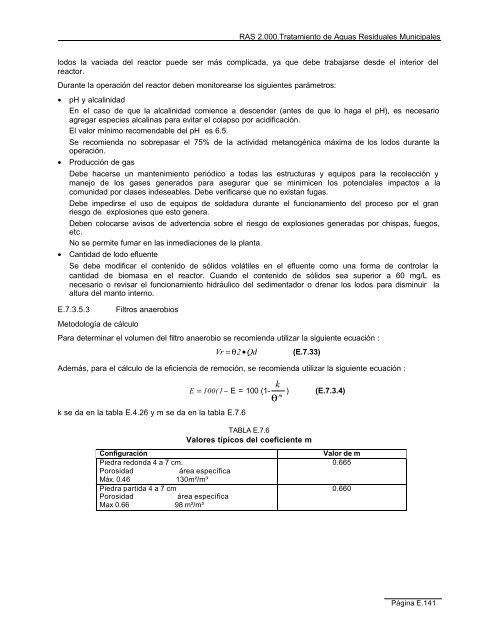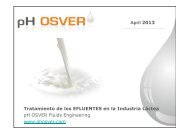7._Tratamiento_de_aguas_residuales
Create successful ePaper yourself
Turn your PDF publications into a flip-book with our unique Google optimized e-Paper software.
RAS 2.000.<strong>Tratamiento</strong> <strong>de</strong> Aguas Residuales Municipales<br />
Se (exp( − ksD)) / q<br />
=<br />
n<br />
So ( 1 + R ) − exp( − K D / q )<br />
s<br />
n<br />
(E.<strong>7.</strong>29)<br />
E.<strong>7.</strong>3.4.1.7<br />
Fórmula Galler y Gotaas<br />
119 .<br />
K( QLo<br />
+ RLe<br />
)<br />
Le =<br />
( Q + R ) ( 1+<br />
D)<br />
a<br />
078 . 0. 67 0.<br />
25<br />
Don<strong>de</strong> K = 0 464 43560 0 13<br />
. ( / π ) .<br />
0. 28 0.<br />
15<br />
Q t<br />
(E.<strong>7.</strong>30)<br />
(E.<strong>7.</strong>31)<br />
E.<strong>7.</strong>3.4.1.8<br />
Mo<strong>de</strong>lo <strong>de</strong> Kincannon y Stover<br />
8. 34QSo / ( µ max So<br />
)<br />
As =<br />
− K<br />
( S − S )<br />
o<br />
e<br />
b<br />
(E.<strong>7.</strong>32)<br />
TABLA E.<strong>7.</strong>5<br />
Valores <strong>de</strong> k para la ecuación alemana, implícitos en la fórmula NRC<br />
Carga DBO5<br />
kg/100m 3·d<br />
Tasa<br />
hidráulica,<br />
m 3 /m 2·d<br />
Eficiencia, NRC, %<br />
Valores k calculados a<br />
R=0 R=1 R=2 R=0 R=1 R=2<br />
25.0 0.158 81.9 85.3 86.7 0.072 0.081 0.086<br />
50.0 0.315 76.2 80.5 82.2 0.086 0.098 0.103<br />
74.8 0.473 72.3 7<strong>7.</strong>1 79.1 0.094 0.108 0.115<br />
99.8 0.632 69.4 74.4 76.6 0.100 0.116 0.127<br />
149.8 0.947 64.9 70.4 72.7 0.109 0.126 0.135<br />
199.6 1.264 61.6 6<strong>7.</strong>3 69.8 0.115 0.134 0.144<br />
a<br />
D = 1.83 m, Lo = 120mgDBO 5 /L, n= 0.5<br />
La metodología propuesta <strong>de</strong> cálculo es la siguiente :<br />
1. Cálculo <strong>de</strong> la eficiencia requerida<br />
2. Calculo <strong>de</strong>l volumen requerido en el filtro para la eficiencia encontrada anteriormente<br />
por la fórmula NRC<br />
3. Calcule la profundidad requerida para expandir el filtro con el volumen anterior y<br />
asumiendo el diámetro <strong>de</strong> filtro.<br />
4. De la siguiente figura seleccionar al valor <strong>de</strong> K 20 .<br />
5. Determine la tasa hidráulica <strong>de</strong> la biotorre y el diámetro correspondiente.<br />
Página E.138






